Coelom Study guides, Class notes & Summaries
Looking for the best study guides, study notes and summaries about Coelom? On this page you'll find 200 study documents about Coelom.
Page 4 out of 200 results
Sort by
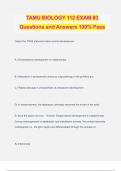
-
TAMU BIOLOGY 112 EXAM #3 Questions and Answers 100% Pass
- Exam (elaborations) • 33 pages • 2024
- Available in package deal
-
- $13.49
- + learn more
TAMU BIOLOGY 112 EXAM #3 Questions and Answers 100% Pass Select the TRUE statement about animal development: A.) Deuterostome development is indeterminate. B.) Mesoderm in protostomes arises as outpocketings of the primitive gut. C.) Radial cleavage is characteristic of protostome development. D) In deuterostomes, the blastopore ultimately becomes the mouth of the adult. E) All of the above are true. - Answer- Deuterostome development is indeterminate. During embryogenesis of diploblasti...
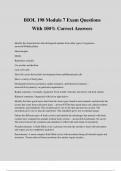
-
BIOL 198 Module 7 Exam Questions With 100% Correct Answers
- Exam (elaborations) • 18 pages • 2024
- Available in package deal
-
- $12.49
- + learn more
BIOL 198 Module 7 Exam Questions With 100% Correct Answers Identify the characteristics that distinguish animals from other types of organisms. - answerMulticellular Heterotrophic Motile Reproduce sexually Use aerobic metabolism Lack cell walls Have life cycles that include development from undifferentiated cells Have a variety of body plans Distinguish between asymmetry, radial symmetry, and bilateral symmetry. - answerAsymmetry: no particular organization Radial symmetry: Circular...
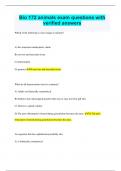
-
Bio 172 animals exam questions with verified answers
- Exam (elaborations) • 19 pages • 2024
- Available in package deal
-
- $9.99
- + learn more
Bio 172 animals exam questions with verified answers Which of the following is (are) unique to animals? A) the structural carbohydrate, chitin B) nervous and muscular tissue C) heterotrophy D) gametes B) nervous and muscular tissue What do all deuterostomes have in common? A) Adults are bilaterally symmetrical. B) Embryos have pharyngeal pouches that may or may not form gill slits. C) All have a spinal column. D) The pore (blastopore) formed during gastrulation becomes the anu...
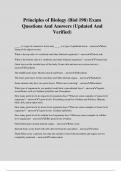
-
Principles of Biology (Biol 198) Exam Questions And Answers (Updated And Verified)
- Exam (elaborations) • 29 pages • 2024
-
- $13.49
- + learn more
Principles of Biology (Biol 198) Exam Questions And Answers (Updated And Verified) _____ is a type of connective tissue and _____ is a type of epithelial tissue. - answerBone; lining of the digestive tract What is the top side of a vertebrate and other bilateral organisms? - answerDorsal side What is the bottom side of a vertebrate and other bilateral organisms? - answerVentral side Germ layer on the outside layer of the body. Forms skin and nervous system (nerves). - answerEctoderm The...
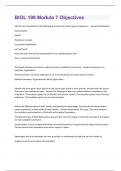
-
BIOL 198 Module 7 Objectives Questions & Answers Already Passed!!
- Exam (elaborations) • 19 pages • 2024
- Available in package deal
-
- $6.79
- + learn more
Identify the characteristics that distinguish animals from other types of organisms. - Answer-Multicellular Heterotrophic Motile Reproduce sexually Use aerobic metabolism Lack cell walls Have life cycles that include development from undifferentiated cells Have a variety of body plans Distinguish between asymmetry, radial symmetry, and bilateral symmetry. - Answer-Asymmetry: no particular organization Radial symmetry: Circularly organized. If cut in half vertically, the halves will loo...
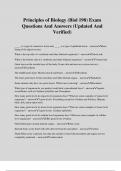
-
Principles of Biology (Biol 198) Exam Questions And Answers (Updated And Verified)
- Exam (elaborations) • 29 pages • 2024
-
- $13.49
- + learn more
Principles of Biology (Biol 198) Exam Questions And Answers (Updated And Verified) _____ is a type of connective tissue and _____ is a type of epithelial tissue. - answerBone; lining of the digestive tract What is the top side of a vertebrate and other bilateral organisms? - answerDorsal side What is the bottom side of a vertebrate and other bilateral organisms? - answerVentral side Germ layer on the outside layer of the body. Forms skin and nervous system (nerves). - answerEctoderm The...
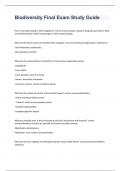
-
Biodiversity Final Exam Study Guide with correct answers
- Exam (elaborations) • 21 pages • 2023
- Available in package deal
-
- $13.99
- + learn more
How is Animalia related to other kingdoms? correct answersclosely related to fungi because they're both chemoheterotrophs, both have glycogen as their energy storage. What are the three classes of Annelida? Give examples. correct answersClass Oligochaeta- earthworms Class Polychaeta- polychaetes Class Hirudinea- leeches What are the characteristics of Annelids? correct answers-segmented worms -triploblastic -true coelom -some parasitic, some free-living -marine, terrestrial, fresh...

-
Bio 117 exam 2 quiz with 100% correct solutions
- Exam (elaborations) • 49 pages • 2024
-
- $13.49
- + learn more
Bio 117 exam 2 quiz with 100% correct solutions Which of the following is NOT a characteristic of ALL animals? A. Heterotrophic B. Together, they form a monophyletic group. C. Multicellular organisms D. Cells lacking cell walls. E. All animals have true tissues and organs. - Correct Answer ️️ -All animals have true tissues and organs. Which of the following are characteristics of Phylum Cnidaria? (Select All that Apply) A. Specialized stinging cells B. True Tissues C. Comp...
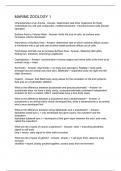
-
Marine Zoology #1
- Exam (elaborations) • 3 pages • 2024
-
- $9.99
- + learn more
Characteristics of an Animal - Answer- heterotroph (eat other organisms for food), multicellular (no cell wall, eukaryotic), motility/movement, *neurons/muscle cells (except sponges) Surface Area to Volume Ratio - Answer- limits the size of cells, as surface area increases volume decreases Importance of Surface Area - Answer- determines rate at which nutrients diffuse across a membrane into a cell and rate at which waste products diffuse out of cells Techniques Animals use to Increase S...
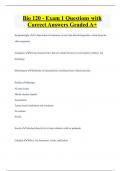
-
Bio 120 - Exam 1 Questions with Correct Answers Graded A+
- Exam (elaborations) • 39 pages • 2024
- Available in package deal
-
- $14.99
- + learn more
Bio 120 - Exam 1 Questions with Correct Answers Graded A+ Synapomorphy A shared derived character or trait state that distinguishes a clade from the other organisms. Analagous Having characteristics that are similar because of convergent evolution, not homology. Homologous Similarity in characteristics resulting from a shared ancestry. Porifera Sponges No true tissues Mostly marine, aquatic Asymmetric 2 germ layers (endoderm and ectoderm) No coelom Sessile

Did you know that on average a seller on Stuvia earns $82 per month selling study resources? Hmm, hint, hint. Discover all about earning on Stuvia


